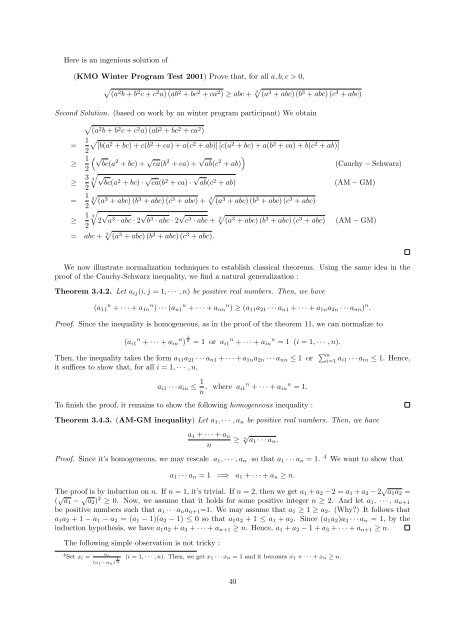Topics in Inequalities - Theorems and Techniques Hojoo ... - Index of
Topics in Inequalities - Theorems and Techniques Hojoo ... - Index of
Topics in Inequalities - Theorems and Techniques Hojoo ... - Index of
You also want an ePaper? Increase the reach of your titles
YUMPU automatically turns print PDFs into web optimized ePapers that Google loves.
Here is an <strong>in</strong>genious solution <strong>of</strong><br />
(KMO W<strong>in</strong>ter Program Test 2001) Prove that, for all a, b, c > 0,<br />
√<br />
(a2 b + b 2 c + c 2 a) (ab 2 + bc 2 + ca 2 ) ≥ abc + 3√ (a 3 + abc) (b 3 + abc) (c 3 + abc)<br />
Second Solution. (based on work by an w<strong>in</strong>ter program participant) We obta<strong>in</strong><br />
√<br />
(a2 b + b 2 c + c 2 a) (ab 2 + bc 2 + ca 2 )<br />
=<br />
2√ 1 [b(a2 + bc) + c(b 2 + ca) + a(c 2 + ab)] [c(a 2 + bc) + a(b 2 + ca) + b(c 2 + ab)]<br />
≥ 1 (√<br />
bc(a 2 + bc) + √ ca(b 2 + ca) + √ )<br />
ab(c 2 + ab)<br />
(Cauchy − Schwarz)<br />
2<br />
≥ 3 2<br />
√<br />
3 √bc(a2<br />
+ bc) · √ca(b 2 + ca) · √ab(c 2 + ab)<br />
(AM − GM)<br />
= 1 √<br />
3<br />
(a3 + abc) (b<br />
2<br />
3 + abc) (c 3 + abc) + 3√ (a 3 + abc) (b 3 + abc) (c 3 + abc)<br />
≥ 1 √<br />
3<br />
2 √ a<br />
2<br />
3 · abc · 2 √ b 3 · abc · 2 √ c 3 · abc + 3√ (a 3 + abc) (b 3 + abc) (c 3 + abc) (AM − GM)<br />
= abc + 3√ (a 3 + abc) (b 3 + abc) (c 3 + abc).<br />
We now illustrate normalization techniques to establish classical theorems. Us<strong>in</strong>g the same idea <strong>in</strong> the<br />
pro<strong>of</strong> <strong>of</strong> the Cauchy-Schwarz <strong>in</strong>equality, we f<strong>in</strong>d a natural generalization :<br />
Theorem 3.4.2. Let a ij (i, j = 1, · · · , n) be positive real numbers. Then, we have<br />
(a 11 n + · · · + a 1n n ) · · · (a n1 n + · · · + a nn n ) ≥ (a 11 a 21 · · · a n1 + · · · + a 1n a 2n · · · a nn ) n .<br />
Pro<strong>of</strong>. S<strong>in</strong>ce the <strong>in</strong>equality is homogeneous, as <strong>in</strong> the pro<strong>of</strong> <strong>of</strong> the theorem 11, we can normalize to<br />
(a i1 n + · · · + a <strong>in</strong> n ) 1 n<br />
= 1 or a i1 n + · · · + a <strong>in</strong> n = 1 (i = 1, · · · , n).<br />
Then, the <strong>in</strong>equality takes the form a 11 a 21 · · · a n1 + · · · + a 1n a 2n · · · a nn ≤ 1 or ∑ n<br />
i=1 a i1 · · · a <strong>in</strong> ≤ 1. Hence,<br />
it suffices to show that, for all i = 1, · · · , n,<br />
a i1 · · · a <strong>in</strong> ≤ 1 n , where a i1 n + · · · + a <strong>in</strong> n = 1.<br />
To f<strong>in</strong>ish the pro<strong>of</strong>, it rema<strong>in</strong>s to show the follow<strong>in</strong>g homogeneous <strong>in</strong>equality :<br />
Theorem 3.4.3. (AM-GM <strong>in</strong>equality) Let a 1 , · · · , a n be positive real numbers. Then, we have<br />
a 1 + · · · + a n<br />
n<br />
≥ n√ a 1 · · · a n .<br />
Pro<strong>of</strong>. S<strong>in</strong>ce it’s homogeneous, we may rescale a 1 , · · · , a n<br />
so that a 1 · · · a n = 1. 4 We want to show that<br />
a 1 · · · a n = 1 =⇒ a 1 + · · · + a n ≥ n.<br />
The pro<strong>of</strong> is by <strong>in</strong>duction on n. If n = 1, it’s trivial. If n = 2, then we get a 1 + a 2 − 2 = a 1 + a 2 − 2 √ a 1 a 2 =<br />
( √ a 1 − √ a 2 ) 2 ≥ 0. Now, we assume that it holds for some positive <strong>in</strong>teger n ≥ 2. And let a 1 , · · · , a n+1<br />
be positive numbers such that a 1 · · · a n a n+1 =1. We may assume that a 1 ≥ 1 ≥ a 2 . (Why?) It follows that<br />
a 1 a 2 + 1 − a 1 − a 2 = (a 1 − 1)(a 2 − 1) ≤ 0 so that a 1 a 2 + 1 ≤ a 1 + a 2 . S<strong>in</strong>ce (a 1 a 2 )a 3 · · · a n = 1, by the<br />
<strong>in</strong>duction hypothesis, we have a 1 a 2 + a 3 + · · · + a n+1 ≥ n. Hence, a 1 + a 2 − 1 + a 3 + · · · + a n+1 ≥ n.<br />
The follow<strong>in</strong>g simple observation is not tricky :<br />
a i<br />
4 Set x i =<br />
(a 1···a n ) n<br />
1<br />
(i = 1, · · · , n). Then, we get x 1 · · · x n = 1 <strong>and</strong> it becomes x 1 + · · · + x n ≥ n.<br />
40

















